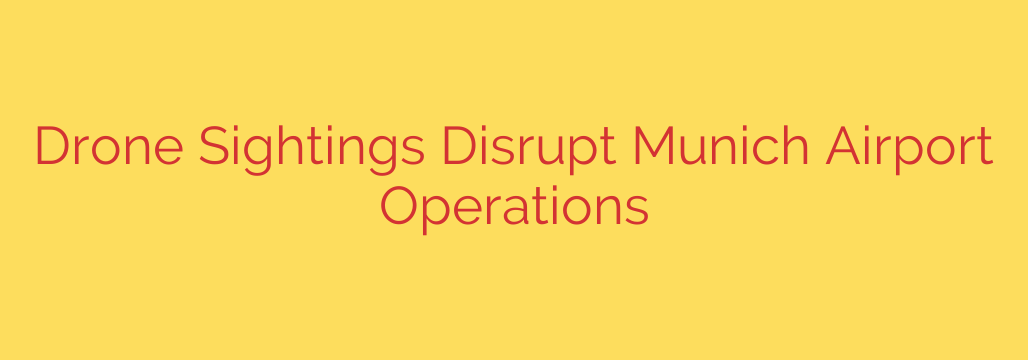
Munich Airport Operations Halted: The Serious Threat of Unauthorized Drones
Operations at Munich Airport were brought to a standstill following confirmed sightings of an unauthorized drone near the airfield, forcing a temporary shutdown of all takeoffs and landings. This incident highlights a growing and dangerous problem facing the aviation industry worldwide: the illegal operation of drones in restricted airspace. The swift response, which included grounding flights and deploying police, underscores the serious nature of this threat to passenger safety and airport security.
When a drone is spotted near an airport, the protocol is immediate and severe. Air traffic controllers must halt all activity to prevent a potential collision, creating a ripple effect of delays, diversions, and cancellations that can affect thousands of passengers and cost airlines millions in operational losses.
Why Are Drones Near Airports So Dangerous?
But what makes a small, remotely-piloted aircraft such a profound threat to a multi-ton passenger jet? The danger is multifaceted and severe.
- Risk of Catastrophic Collision: The primary concern is a direct physical impact. A drone ingested into a jet engine can cause catastrophic engine failure, especially during the critical phases of takeoff or landing. Similarly, a collision with a cockpit windshield, wing, or tail could compromise the aircraft’s structural integrity and control systems.
- Pilot Distraction: Even without a direct collision, the mere presence of a drone in a pilot’s field of vision during approach or departure creates a significant distraction. This forces pilots to divert their attention from critical flight procedures at a time when their focus must be absolute.
- Interference with Navigation: Drones can potentially interfere with an aircraft’s sensitive communication and navigation systems, creating confusion and uncertainty in the cockpit and for air traffic control.
The disruption caused by the drone sighting at Munich Airport is not just an inconvenience; it is a direct consequence of a significant safety risk. The “better safe than sorry” approach of grounding flights is the only responsible course of action when an unknown aerial object enters controlled airspace.
The Broader Impact: Delays, Costs, and Security Challenges
The immediate shutdown of an airport runway triggers a logistical nightmare. For passengers, it means unexpected delays, missed connections, and stressful uncertainty. For airlines and the airport, the financial toll is immense, encompassing fuel costs for rerouted or circling aircraft, crew rescheduling, and passenger compensation.
This incident also brings the challenge of airport security into sharp focus. Detecting and neutralizing a small, fast-moving drone is incredibly difficult. Airports are increasingly investing in sophisticated anti-drone technology, including:
- Radar and Radio Frequency (RF) Scanners to detect unauthorized devices.
- High-Resolution Cameras to identify and track drones.
- Jamming Technology to disrupt the control signal between the drone and its operator.
However, no system is foolproof, and the responsibility ultimately falls on drone operators to fly legally and safely.
A Guide to Responsible Drone Operation
For drone enthusiasts and commercial operators, understanding and respecting aviation rules is non-negotiable. Flying a drone near an airport is illegal and carries severe penalties, including hefty fines and potential prison time.
Here are essential safety tips every drone pilot must follow:
- Know Your No-Fly Zones: Airports, military bases, and critical infrastructure are strictly off-limits. Use apps like the FAA’s B4UFLY or local equivalents to check airspace restrictions before every flight.
- Maintain Visual Line of Sight: Always keep your drone within your sight. This ensures you are aware of its position and can avoid potential hazards.
- Fly Below Maximum Altitude: Adhere to the legal altitude limits in your country (typically 400 feet or 120 meters) to stay clear of manned aircraft.
- Register Your Drone: If required by your local aviation authority, ensure your drone is properly registered and labeled.
The incident at Munich Airport serves as a stark reminder of the real-world consequences of irresponsible drone use. As this technology becomes more accessible, a shared commitment to education, strict enforcement, and responsible operation is the only way to ensure the safety of our skies.
Source: https://go.theregister.com/feed/www.theregister.com/2025/10/03/munich_airport_drone/








